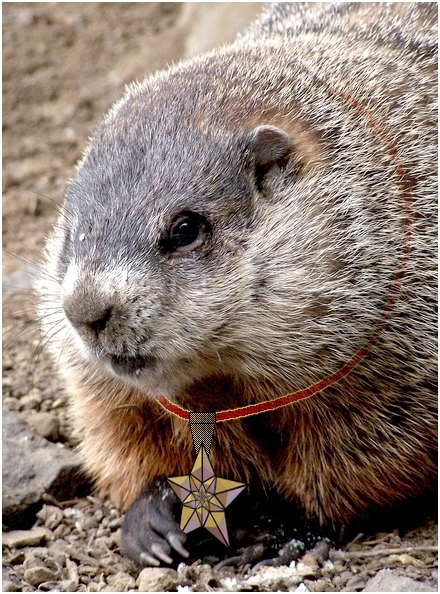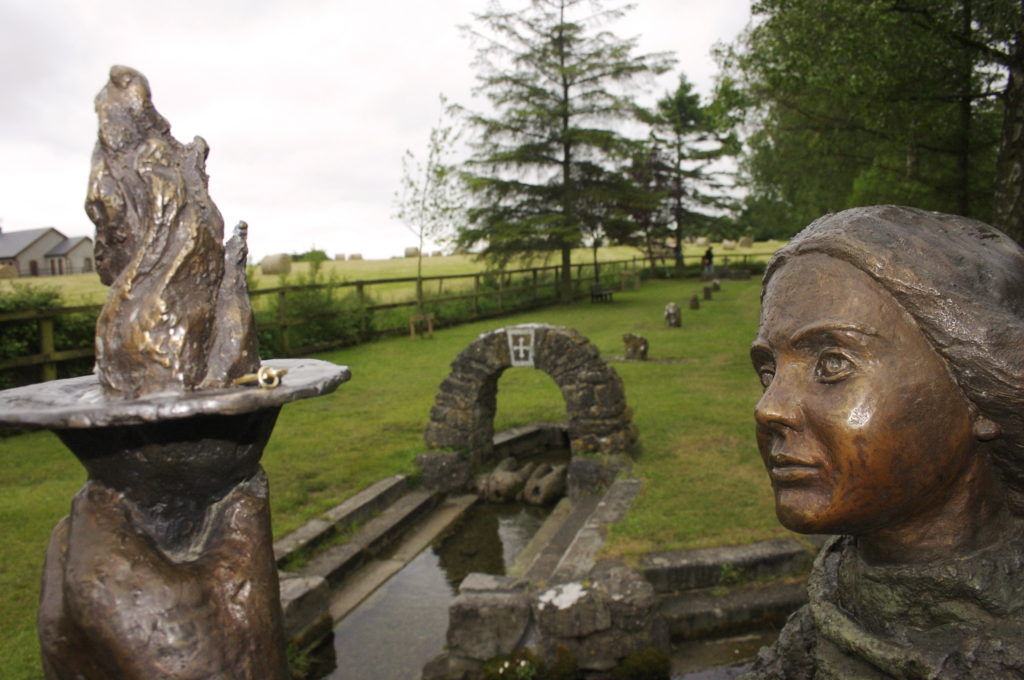Imbolc draws its roots from an ancient Celtic celebration and today is frequently centered around the Goddess Brigid. The more recent incarnation of Brigid’s Flame burns brightly in Kildare, Ireland, tended by Sister Mary Teresa Cullen of Brigidine Sisters in Solas Bhride.
The flame was re-lit in 1993, and publicly displayed in 2006 in a sculpture commissioned in 2005 by the Kildare County Council. The sculpture itself is composed of a twisted column which at the top has large oak leaves that hold a bronze acorn cup where the flame resides. Solas Bhride identifies the components represented as, “The use of oak leaves symbolises both the Christian beliefs of St. Brigid and the earlier Druidic worship of the trees. Of course, the oak is also the namesake of Kildare, Cill Dara, Church of the Oak.”

[Brigid’s Flame – Kildare – courtesy s. bustamonte]
There is a magic to Imbolc and the works of Brigid that can make a person believe in the ability to accomplish the impossible through the mundane. Perusing the many stories of Brigid, whether it is one where she turns the leper’s bathwater into beer in order to have something to offer when the bishop and his full retinue turned up unexpectedly for a visit; or the expansion of her cloak to cover much of Ireland when the king told her he would deed her all the land that she cover with it; or the taming of a fox to replace the favorite tamed fox of the king that a hunter had killed, sparing the life of the hunter; all rather ordinary things used extraordinarily.

[pixabay]
The honoring of hearth and home, and homely endeavors – that remind us that we can weave magic into the simplest of tasks- is perhaps the very embodiment of Imbolc. They are also reminders that we must tend our own inner fires, as we await the arrival of Spring and the Vernal Equinox.
* * *
Here are some reflections of others on the season collected from various blogs:
“The divinatory readings I’ve done speak of stillness, pausing, internal work, and a marshalling of resources and strength. Though it has been years since I’ve worked with runes, I felt them calling to me again. Reaching into my runebag, I drew Laguz and Ingwaz, two runes that stand right beside each other in the third aett of the Elder Futhark. Laguz is water, the cosmic sea, the feminine principle, the unconscious. It is the inner work I’ve been doing for months now. Ingwaz is the seed, the potential, the masculine principle, and the inner child. It is the sacrifice of one form to create a new one. It is an initiation, one that I cannot bypass. The waters of the unconscious have watered the seed, and so it will grow.
What could be more reflective of Imbolc and of my own life right now, even if my subtropical surroundings hurry toward spring? We do not merely observe these seasons; we live them, and they live through us. They teach us with every turn of the wheel.”
From Jen, Southern Witch: Exploring Pagan Beliefs and Practices in the Rural South, SageWoman Blogs
* * *

[By Ruhrfisch at English Wikipedia, CC BY-SA 3.0, wikimedia commons]
In case you happened to forget the other references of the day:
‘ “Sign superstitions regarding weather are known to all, the most famous being the groundhog oracle which provides that if the groundhog sees his shadow on the second of February (which, in the church calendar, is Candlemass) there will be six more weeks of winter.” (Western Folklore, 1954)
Several folk proverbs from around Europe speak to this tradition:
From England:
“If Candlemas be fair and bright,
Winter has another flight.
If Candlemas brings clouds and rain,
Winter will not come again.”
From Scotland:
“If Candlemas Day is bright and clear,
There’ll be two winters in the year.”
From Germany:
“The badger peeps out his hole on Candlemas Day, and, if he finds snow, walks abroad; but if he sees the sun shining he draws back into his hole.” ‘
From The Wandering Witch by Julia Penelope on Patheos.com
* * *
“It is Winter; the wind howls and Mother Nature lies sleeping, deep under a blanket of snow. Bare branches, stark against the slate gray sky, crack against each other like knucklebones, and when the winds really howl they snap, hitting the snow covered ground with a hushed thump.
On the Great Wheel of the Year, this is the time of Imbolc. In the Celtic seasonal calendar, Imbolc marked the beginning of the lambing season. The ewes came into their milk and the first stirrings of Spring began.
This is the ‘quickening of the year’; there is a spark hidden below the surface, like a new pregnancy, barely perceptible and yet urgently anticipated and holding great promise. The seed stirs in the belly of the Earth.”
Pagan Imbolc Stirs the Spirit, Shakes Off the Winter Blues, Parliament Blog, by Rev. Angie Buchanan (1.30.2014)
* * *

[Brigid’s Well – Kildare – courtesy s. bustamonte]
“There is a flame that burns at Kildare, a symbol beyond labels, the fire of love, the flame of peace. Once tended by followers of the Celtic goddess Brigid, now the keepers of the flame honor Saint Brigid. Do the labels matter?
This Candlemas season I mourn the passing of the great poet Mary Oliver. Nature awed her. She rightly identified Earth as a spiritual cauldron. When I think of the flame in the cauldron at Kildare kept alive in the name of hope, justice and peace, I think about what Oliver may have made of it. In her poem, “I Wake Close to Morning,” Oliver asks why people ask God for I.D. when each day, dawn breaking is enough.
And dawn will break earlier and earlier now as the wheel turns on this sabbat, halfway between Winter Solstice and Spring Equinox. It is the time of Imbolc, the birthing of the lambs. In agricultural societies, a sure sign that spring is on its way despite the cold, bitter winds of winter gripping Earth.”
From The Flame That Will Not Be Extinguished by Nan Lundeen on Patheos.com
The Wild Hunt is not responsible for links to external content.
To join a conversation on this post:
Visit our The Wild Hunt subreddit! Point your favorite browser to https://www.reddit.com/r/The_Wild_Hunt_News/, then click “JOIN”. Make sure to click the bell, too, to be notified of new articles posted to our subreddit.
